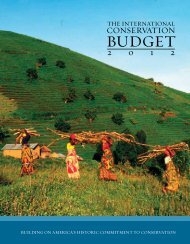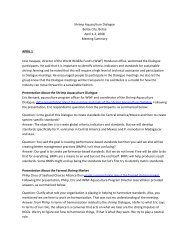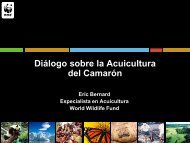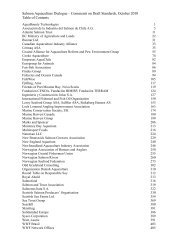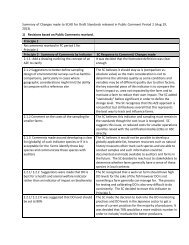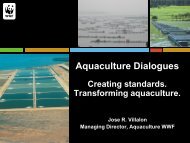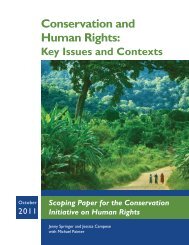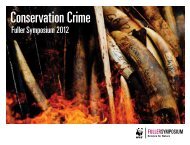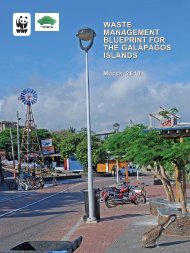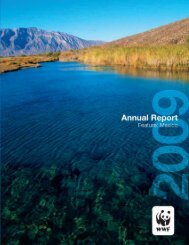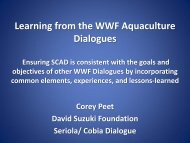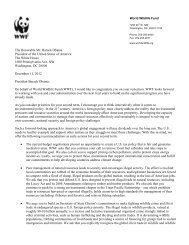Guidelines and Resources - World Wildlife Fund
Guidelines and Resources - World Wildlife Fund
Guidelines and Resources - World Wildlife Fund
Create successful ePaper yourself
Turn your PDF publications into a flip-book with our unique Google optimized e-Paper software.
© Brent Stirton / Getty ImageWORKING PAPEROCTOBER2011Free, Prior, Informed Consent<strong>and</strong> REDD+: <strong>Guidelines</strong> <strong>and</strong><strong>Resources</strong>
Contents• Background1• What is FPIC?2• What is WWF policy on FPIC?2• Why is FPIC important to REDD?2• What are guiding principles for FPIC?3• What are general procedures for FPIC (key elements)?3• Additional resources on FPIC7This document has been produced as a Working Paper to invite comments <strong>and</strong> feedback. Please send anycomments to people<strong>and</strong>conservation@wwfus.org.WWF gratefully acknowledges support received from Norad to produce this working paper.
Key Points• FPIC refers to the principle that indigenous peoples have a right to give or withhold consentto actions that will affect them, especially actions affecting their traditional l<strong>and</strong>s, territories<strong>and</strong> natural resources.• WWF’s Statement of Principles on Indigenous Peoples <strong>and</strong> Conservation recognizes theright of indigenous peoples to FPIC from governments on projects affecting their customaryl<strong>and</strong>s <strong>and</strong> resources, <strong>and</strong> states that WWF will not promote or support interventions affectingcustomary l<strong>and</strong>s <strong>and</strong> resources that have not received FPIC.• FPIC is highly relevant to REDD+ because REDD+ will involve changes in forest use that canaffect the rights <strong>and</strong> livelihoods of indigenous peoples <strong>and</strong> local communities. FPIC enablescommunities to safeguard their rights <strong>and</strong> interests, <strong>and</strong> also shape REDD+ initiatives tosupport communities in ways that will contribute to successful outcomes.• While WWF will not act as proponent of REDD+ projects, FPIC remains relevant to otherroles WWF may play such as capacity-building, project initiating <strong>and</strong> informing the developmentof REDD+ policy frameworks.• Practical methodologies for FPIC are still evolving, <strong>and</strong> need to be specific to local cultures<strong>and</strong> contexts. However, a number of recent publications have outlined general procedures forFPIC, as a resource for ensuring that rights to FPIC are respected <strong>and</strong> supported. This workingpaper outlines a general set of procedures for use by WWF programs working on REDD+,drawing in particular on recent guidance from RECOFTC/GIZ, Oxfam <strong>and</strong> the Forest PeoplesProgram.• The concluding section of the paper provides an annotated compilation of Additional<strong>Resources</strong> on which programs can draw for more in-depth information.BackgroundThe emergence of Reducing Emissions from Deforestation <strong>and</strong> Degradation, <strong>and</strong> conserving, sustainablymanaging <strong>and</strong> enhancing forest carbon stocks (REDD+) has generated great interest as a possible wayto increase support for the forest stewardship activities of indigenous peoples <strong>and</strong> local communities.Potential benefits associated with REDD+ initiatives include strengthening of community l<strong>and</strong> <strong>and</strong>resource rights, empowerment of community institutions <strong>and</strong> increased income through benefit sharing.At the same time, REDD+ has sparked concern about possible adverse impacts on indigenous <strong>and</strong> communityrights <strong>and</strong> livelihoods, including restrictions on l<strong>and</strong> <strong>and</strong> resource rights, increased centralizationof forest management, <strong>and</strong> inequitable benefit-sharing.Free, prior, informed consent of indigenous peoples <strong>and</strong> other forest-dependent communities is widelyrecognized as a key foundation for securing the opportunities that REDD+ may provide <strong>and</strong> addressingits risks, contributing to more equitable, effective <strong>and</strong> sustainable REDD+ initiatives. At the same time,practical challenges to effective realization of FPIC remain. A number of recent publications <strong>and</strong> currentprocesses seek to address these, including through development of practical guidelines <strong>and</strong> procedures.One purpose of this working paper is to distill these practical guidelines into guiding principles <strong>and</strong>procedures for WWF programs working on REDD+, as a resource for ensuring that rights to FPIC arerespected <strong>and</strong> supported. The paper also provides an annotated compilation of additional, more in-depthresource materials on which programs can draw.1
What is Free, Prior, Informed Consent?Free, prior <strong>and</strong> informed consent (FPIC) refers to the principle that indigenous peoples have a right togive or withhold consent to actions that will affect them, especially actions affecting their l<strong>and</strong>s, territories<strong>and</strong> natural resources. FPIC is recognized in the United Nations Declaration on the Rights of IndigenousPeoples (UNDRIP) <strong>and</strong> elsewhere, <strong>and</strong> is linked to collective rights to property <strong>and</strong> self-determination.FPIC has evolved as a protection against the often-devastating impacts on communities when theyare left out of planning <strong>and</strong> decision-making processes, especially about large-scale development projects<strong>and</strong> other l<strong>and</strong> use changes. While most clearly established as a right of indigenous peoples, it is increasinglyrecognized that the basic principles underlying FPIC are also relevant to non-indigenous communities. iFPIC is increasingly recognized as “best practice” in conservation <strong>and</strong> development, to avoid conflicts<strong>and</strong> ground activities in equitable agreements with indigenous communities, including to fair benefitsfrom activities on their l<strong>and</strong>s. ii FPIC enables communities to assess the potential benefits <strong>and</strong> risks ofREDD+ initiatives, influence their design to reduce risks <strong>and</strong> promote benefits, <strong>and</strong> decide whether ornot to approve or participate in them.What is WWF’s policy on FPIC?WWF’s Statement of Principles on Indigenous Peoples <strong>and</strong> Conservation recognizes the right of indigenouspeoples to free, prior, informed consent from governments on projects affecting their customaryl<strong>and</strong>s <strong>and</strong> resources. It further states that WWF will not promote or support, <strong>and</strong> may actively oppose,interventions affecting customary l<strong>and</strong>s <strong>and</strong> resources that have not received free, prior, informed consent.In the context of REDD+ specifically, WWF’s Guiding Principles for REDD+ highlight respect for therights of indigenous peoples <strong>and</strong> local communities as one of five key principles for REDD+, <strong>and</strong> includeFPIC as a criterion for this. While WWF has determined that it will not act as a proponent of REDD+projects (i.e., will not own or benefit from carbon credits), underst<strong>and</strong>ing of FPIC principles <strong>and</strong> proceduresis also relevant to roles – such as awareness raising (providing information about REDD+) orinitiating (co-developing demonstration projects within a national framework) – that WWF may play. Inaddition, it is important to stay informed of the extent to which consent processes are being upheld byothers in areas where WWF may be working on related activities, in order to adhere to WWF policy commitmentsnot to support activities in indigenous l<strong>and</strong>s that have not secured FPIC. Finally, WWF programscan support other stakeholders <strong>and</strong> partners (government, private sector <strong>and</strong> other civil societyactors) to strengthen their underst<strong>and</strong>ing of <strong>and</strong> commitment to FPIC, <strong>and</strong> to inform integration of FPICin REDD+ policies – in order to contribute to more effective REDD+ outcomes.Why is FPIC important to REDD+?FPIC has received significant attention in the context of REDD+ because reducing emissions from deforestationwill require changes in how forest l<strong>and</strong> is used. Depending on how they are carried out, thesechanges may support or undermine the rights <strong>and</strong> livelihoods of indigenous peoples <strong>and</strong> local communities.For example, there is a risk that governments may restrict activities perceived to be contributing todeforestation <strong>and</strong> degradation, or re-centralize resource management, disrupting local institutions <strong>and</strong>management systems. Negative impacts on community rights <strong>and</strong> livelihoods, in turn, generate missedopportunities to engage the substantial knowledge <strong>and</strong> capacities of indigenous <strong>and</strong> local communities tocontribute to forest stewardship. FPIC enables communities to guard against negative impacts, <strong>and</strong> alsoshape REDD+ initiatives to support traditional knowledge, management systems <strong>and</strong> livelihoods thatwill be vital for successful programs.2
Recognition of rights to Free, Prior, Informed Consent in relation to REDD+ has been a central part ofthe platform of indigenous peoples’ organizations engaging in UNFCCC policy processes. iii The December2010 Cancun Agreement (Annex 1) adopted “Respect for the Rights of indigenous peoples <strong>and</strong> membersof local communities, noting adoption of UNDRIP” as a safeguard for REDD+ programs. While notexplicitly stated, this implies that FPIC is to be applied in the context of REDD+, as FPIC is one of theprovisions of UNDRIP. ivAmong donor initiatives, the UN-REDD Programme has made an explicit commitment to adhere to theUN Declaration on the Rights of Indigenous Peoples, including FPIC. To put this commitment into practice,UN-REDD has carried out a series of regional consultation meetings on FPIC <strong>and</strong> drafted guidelinesfor FPIC in the context of REDD+ programs (see the UN-REDD Programme Materials section underAdditional <strong>Resources</strong>, below). UN-REDD has also piloted an FPIC process in Vietnam, documented theresults, <strong>and</strong> had the process evaluated externally. vAmong voluntary st<strong>and</strong>ards, REDD+ International Social <strong>and</strong> Environmental St<strong>and</strong>ards for governmentledprograms, developed with support from CCBA <strong>and</strong> CARE, also call for the free, prior <strong>and</strong> informedconsent of Indigenous Peoples <strong>and</strong> local communities for any activities affecting their rights to l<strong>and</strong>s,territories <strong>and</strong> resources (1.3). vi These st<strong>and</strong>ards are currently being piloted in a number of national<strong>and</strong> sub-national programs including in Brazil (State of Acre), Ecuador, Indonesia (Central Kalimantan),Nepal <strong>and</strong> Tanzania. vii Similarly, the CCBA voluntary guidelines for REDD projects require documentationof a process for securing FPIC of project-affected communities.What are guiding principles for FPIC?Guiding principles for REDD+ include that decision-making processes will be: viiiFree from coercion, intimidation or manipulation.Prior to allocation of l<strong>and</strong> for particular uses or approval of specific projects. Lead time shouldreflect respect for time requirements of indigenous consultation/consensus processes.Informed, based on full information, at least, about the nature <strong>and</strong> scope of any proposed project oractivity; areas that will be affected; the potential economic, social, cultural <strong>and</strong> environmental risks<strong>and</strong> benefits; <strong>and</strong> organizations/actors likely to be involved in the project. Information should be ina language easily understood by the affected people, delivered in a culturally-appropriate way, <strong>and</strong>available from independent sources.Consent requires time <strong>and</strong> an effective system for communicating among all affected communitymembers <strong>and</strong> taking decisions through customary or other community-defined decision-making processes.It requires that affected people are able to say yes or no at each stage of the project. Consentshould result in equitable agreements, <strong>and</strong> should be part of ongoing processes of communication<strong>and</strong> negotiation, rather than a one-off action.What are general procedures for FPIC?As highlighted by Anderson 2011, “Respecting the right to FPIC is, by definition, a locally <strong>and</strong> culturallyspecific process in which the affected communities themselves determine the steps involved. It is thereforenot possible to produce a universally applicable “how to do it” guideline”. However, it is possible toidentify a set of key elements or components of an FPIC process, bearing in mind that these will need tobe adapted through locally-appropriate processes. This section presents an overall outline of proceduresfor FPIC, based largely on existing materials (see Additional <strong>Resources</strong>, below). The procedures presentedhere focus on the project scale, though FPIC is also relevant to national policy processes, <strong>and</strong> the UN-REDD Programme in particular is developing guidance on how the principle of free, prior <strong>and</strong> informedconsent (FPIC) should be applied to UN-REDD activities, including at the national level (see Additional<strong>Resources</strong>).3
In the context of REDD+, emerging best practice is to seek consent at multiple stages; for example, at theoutset of assessments/planning for a project, to project design documents, <strong>and</strong> as a requirement for anycontractual agreements. This implies that processes will be iterative, <strong>and</strong> also that drop-out/no projectoptions need to be built in at each of these stages in case consent is not secured.RECOFTC & GIZ’s recent guidance on FPIC <strong>and</strong> REDD+ identifies the following three levelsof consent:• Consent to discuss the idea for a REDD+ project that will affect community l<strong>and</strong>s <strong>and</strong> resources,• Consent to participate in developing a detailed plan for a project, <strong>and</strong>• Consent to the implementation of the project.From: Anderson 2011. Free, Prior, <strong>and</strong> Informed Consent in REDD+: Principles <strong>and</strong> Approaches for Policy <strong>and</strong>Project Development.Key Elements of an FPIC procedure include: ix1.2.3.Identifying customary l<strong>and</strong>s <strong>and</strong> rights holders.This step is an essential foundation for FPIC as it establishes who the rights-holders to a givenarea are, <strong>and</strong> therefore who needs to give consent to a particular activity. As l<strong>and</strong> claims basedon customary rights are often not formally recognized in law, fulfilling this element may requiresupport for a participatory community mapping process to document community-recognizedrights over forests. Mapping should include different groups within the community (who mayhave differences in knowledge, interests <strong>and</strong> uses of resources) as well as neighboring communities(to validate <strong>and</strong> agree boundaries).Identifying <strong>and</strong> engaging with appropriate community decision-making institutions/authorities.Communities should be represented by institutions they choose themselves through a verifiableprocess, which may differ from institutions set up under government structures. Appropriate decision-makinginstitutions will vary by the scale of the REDD+ initiative. Communities may alsodevelop or designate new bodies to engage in participatory development of a REDD+ initiative;for example, where the geographical scale of the initiative spans several community institutions,or where structures of representative in relation to outsiders are not yet in place. Representationshould be broadly inclusive of all rights-holding communities in the area <strong>and</strong> of all groups withinthe community (women, youth); ensuring full representation of diverse interests may requirespecific attention <strong>and</strong> activities. Where outside facilitation is provided for a consent process, thisshould be provided by a neutral body (without vested interests in the outcome) <strong>and</strong> specificallyagreed with the community.Identifying <strong>and</strong> engaging support organizations.Engaging with support organizations – such as regional or national representative organizationsof indigenous peoples <strong>and</strong>/or expert or advocacy groups on indigenous/community rights– enables communities to access independent information <strong>and</strong> advice about the REDD+ initiativefrom a rights perspective. In addition, support organizations can work with communities topromote enabling policy frameworks for their local activities, where these are not yet in place orneed to be strengthened. Engaging with higher-level organizations also helps promote transparencyof the REDD+ initiative, <strong>and</strong> learning about effective consent processes that can be spreadto other areas.4
4.5.Building mutual underst<strong>and</strong>ing <strong>and</strong> agreement on a locally-appropriate FPIC process.This element addresses the need for outside actors to underst<strong>and</strong> local community decisionmakingprocesses <strong>and</strong> for communities to define their own process as well as expectations regardinginformation <strong>and</strong> support from outside groups. Aspects of the local process may include:who makes decisions, timeframes for community discussions <strong>and</strong> agreement, how potentiallymarginalized groups will be involved, requirements to reach a decision, points along a process atwhich FPIC is needed, <strong>and</strong> how agreements will be documented. Aspects of outside support thatmay need to be defined include how <strong>and</strong> when information about a proposed initiative will becommunicated <strong>and</strong> in what forms, <strong>and</strong> the types of capacity building communities may need tounderst<strong>and</strong> <strong>and</strong> make decisions about the proposed initiative (see also “Providing Information”<strong>and</strong> “Supporting Decision-making,” below). Information-sharing, engagement <strong>and</strong>/or capacitybuilding activities with other entities (government, private sector) may also be needed to buildsupport <strong>and</strong> respect for the FPIC process. The Guiding Principles for FPIC, outlined above, providea useful st<strong>and</strong>ard against which to assess specific processes.Providing information.Information provision addresses the principle that decision-making <strong>and</strong> consent should be informed.Specific relevant information will vary depending on the stage of the work – e.g., initiatinga process, designing a project <strong>and</strong> developing a project implementation agreement. Indicativeexamples of the types of information that may be relevant at different stages of a local REDD+initiative are outlined in the box below.Stage 1 (Initiating process): Information on climate change <strong>and</strong> its impacts, on REDD+ <strong>and</strong> how it is developingin the national context, on the international <strong>and</strong> national context of rights - including to FPIC, assessmentplans, who will be involved.Stage 2 (Project design): Proposed changes in l<strong>and</strong>/resource use, results of assessments of potential impacts<strong>and</strong> costs, benefit sharing arrangements, legal implications, etc.Stage 3 (Project implementation): Specific terms of the implementation agreement, based on the results ofnegotiation.General guidelines on how information should be provided include that it should be:• Open <strong>and</strong> transparent• In locally-appropriate languages <strong>and</strong> forms• Delivered in culturally-appropriate waysGeneral guidelines on what information should be provided include:• Balanced treatment of potential positive <strong>and</strong> negative impacts of an initiative• An assessment of costs <strong>and</strong> benefits, <strong>and</strong> their distribution• Alternatives <strong>and</strong> outcomes of different scenarios• Information on community’s legal rights <strong>and</strong> legal implications of the proposed project(e.g., implications for l<strong>and</strong>/resource rights, status of carbon rights)5
6.7.8.9.10.Engaging in negotiation <strong>and</strong> supporting decision-making.Negotiation consists of a two-way dialogue between communities <strong>and</strong> project proponents or facilitators(government, private sector, NGO) on proposals, interests <strong>and</strong> concerns. In the contextof REDD+ initiatives, key issues are likely to include the nature <strong>and</strong> extent of any changes to forestuse, roles of communities in forest management <strong>and</strong> monitoring, <strong>and</strong> how communities willsecure <strong>and</strong> manage anticipated benefits. Interactive dialogue is likely to be interspersed with periodsof time for community leaders <strong>and</strong> members to freely discuss their concerns <strong>and</strong> proposalsamong themselves. Communities may also need additional technical advice on specific aspects ofproposals under discussion, <strong>and</strong> have rights to independent advice as needed. Ample time shouldbe allowed for a conclusion to this process, which may not conform to st<strong>and</strong>ard project timelines.Documenting consent-based agreements.One distinction between FPIC <strong>and</strong> more general consultation processes is that specific agreementsshould be documented in a mutually-agreed form among all parties. The content of agreementswill vary according to the stage of the work; REDD+ project implementation agreements,for example, would likely include specifics of the agreed costs <strong>and</strong> benefits to the community,resource management requirements <strong>and</strong> any regulations on use. An agreement may also documentforms of capacity-building or technical support to be provided by outside actors to enablecommunities to fulfill obligations, for example in relation to resource management or distributionof benefits. It will be useful to define the general content of REDD+ agreements as part of participatorydevelopment of broader (national or sub-national) policy <strong>and</strong> legal frameworks.Supporting <strong>and</strong> monitoring implementation of agreements.As noted above, community implementation of consent agreements may require ongoing technicalor capacity-building support. Furthermore, monitoring the implementation of agreementsenables parties to hold each other accountable to agreed results as well as to adaptively managewhere actual outcomes may diverge from projections (e.g., of community costs or benefits). Communityrights-holders should be substantively involved at all stages of designing <strong>and</strong> carrying outmonitoring of consent agreements (rather than just carrying out paid data collection).Establishing <strong>and</strong> operating a conflict resolution mechanism.A conflict resolution mechanism provides a process for resolving differences that may arise in thecourse of implementation of agreements. Defining in advance how differences will be communicated<strong>and</strong> resolved helps to ensure that they do not grow into broader conflicts that derail theagreement <strong>and</strong> project. Best practices for conflict resolution (or “grievance”) mechanisms developedfrom private sector experience provide useful guidelines that can be drawn on in REDD+initiatives. xVerifying Consent.Verification by a third party that community consent has been free, prior <strong>and</strong> informed guardsagainst manipulation of FPIC processes <strong>and</strong> enables REDD+ proponents <strong>and</strong> facilitators todemonstrate that they have respected this right in relation to specific initiatives. In the context ofREDD+, third-party verification of FPIC is currently being tested by UN-REDD, for example inVietnam (see UN-REDD Programme Materials under Additional <strong>Resources</strong>).6
Additional <strong>Resources</strong>On FPIC <strong>and</strong> REDD+Free, Prior, <strong>and</strong> Informed Consent in REDD+Patrick Anderson, February 2011 - RECOFTC <strong>and</strong> GIZ | Using relevant examples from a range of locations<strong>and</strong> sectors, this manual provides a basis for developing country-specific guidance on securing FPICin REDD+ processes. It offers guidance on procedures for respecting the right to FPIC <strong>and</strong> details 12elements that need consideration in REDD+ projects to effectively prepare for rights-holder engagement,implement a consent process, <strong>and</strong> maintain consent.UN-REDD Programme materials<strong>Guidelines</strong> for Seeking the Free, Prior, <strong>and</strong> Informed Consent of Indigenous Peoples <strong>and</strong> otherForest Dependent CommunitiesUN-REDD Programme, August 2010 | These draft guidelines - based on recommendations madeby participants at the Asia regional consultation on FPIC <strong>and</strong> Recourse Mechanisms (Vietnam, June2010) respond to the dem<strong>and</strong> from participating countries for concrete guidance on how to seekfree, prior, <strong>and</strong> informed consent <strong>and</strong> provide effective recourse within the context of the UN-REDDProgramme.UN REDD Vietnam workshopUN-REDD Programme, Hanoi, Viet Nam, 16-18 June 2010 | Report of the Asia regional consultationon FPIC, the first of three regional workshops convened to elaborate how the principle of free,prior <strong>and</strong> informed consent (FPIC) should be applied to UN-REDD activities <strong>and</strong> in the context ofREDD+ readiness more broadly.UN-REDD FPIC Workshop in PanamaUN-REDD Programme, Panama, 4-7 October 2010 | At this second of three regional workshops,participants stressed that UN-REDD guidelines should be able to accommodate the specific legalframeworks <strong>and</strong> historical context of Indigenous Peoples in Latin America <strong>and</strong> the Caribbean, whichmay be quite distinct from other regions.UN-REDD Free, Prior <strong>and</strong> Informed Consent Consultation in TanzaniaUN-REDD Programme, Arusha, Tanzania, 24-27 January, 2011 | As the third of three regionalconsultations, this consultation provided the opportunity for indigenous peoples <strong>and</strong> civil societyrepresentatives from Africa to review the consolidated guidelines <strong>and</strong> provide inputs to reflect theirviews <strong>and</strong> regional priorities.Applying the Principle of Free, Prior <strong>and</strong> Informed Consent in the UN-REDD Programme inViet NamUN-REDD Programme, 2010 | This report documents a process to seek FPIC in two pilot districts,as part of Vietnam’s formal preparations for field-based REDD+ activities.Evaluation <strong>and</strong> Verification of the Free, Prior <strong>and</strong> Informed Consent Process under the UN-REDDProgramme: Lam Dong Province, VietnamNguyen Quang Tan, Luong Thi Truong, Nguyen Thi Hai Van <strong>and</strong> K’Tip, November 2010 |RECOFTC. This report presents results of the FPIC evaluation <strong>and</strong> verification process conductedby RECOFTC as part of the UN-REDD Programme’s + pilot project in Vietnam.7
On FPICThe Forest Dialogue: The Forest Dialogue, based at Yale University, is sponsoring a series of dialogueson FPIC as it relates to forest management, which have the main aim of exploring how - in practice- government agencies, commercial enterprises <strong>and</strong> non-government organizations can respect theright of indigenous peoples <strong>and</strong> local communities to give or withhold their free, prior <strong>and</strong> informedconsent to activities that may affect their rights. Associated publications include:Free, Prior <strong>and</strong> Informed Consent – Making FPIC Work for Forests <strong>and</strong> PeoplesMarcus Colchester2010 - The Forest Dialogue |This publication was developed as a scoping paperfor the Forest Dialogue FPIC process.Scoping Dialogue on Free, Prior, <strong>and</strong> Informed Consent13-14 April 2010 - New Haven, CT, USA | This report documents discussions at a two-dayScoping Dialogue for the Free, Prior, <strong>and</strong> Informed Consent series held by The Forest Dialogue inNew Haven, CT, USA on 13–14 April 2010.Field Dialogue on FPIC in Indonesia11-15 October 2010 - Pekanbaru, Riau Province, Indonesia | This report documents the first fielddialogue in the TFD series on FPIC, held in Riau Province on the isl<strong>and</strong> of Sumatra in Indonesia, inOctober 2010.Guide to Free Prior <strong>and</strong> Informed ConsentChristina Hill, Serena Lillywhite <strong>and</strong> Michael Simon 2010 -, Oxfam |This guide is an introduction toFree, Prior <strong>and</strong> Informed Consent (FPIC), developed for use by communities <strong>and</strong> support organizations.It provides basic information about the right to FPIC <strong>and</strong> how this right can help people to have a sayabout development projects, such as dams, mines <strong>and</strong>, logging <strong>and</strong> other large infrastructure projects,which affect them in some way.Free, Prior, Informed Consent <strong>and</strong> the Roundtable on Responsible Palm Oil (RSPO): A Guide for CompaniesForest Peoples Programme, October 2008 |This report provides guidelines for communities <strong>and</strong> companies,<strong>and</strong> also local governments, on procedures to secure FPIC - focused on responsible palm oil butwith broader relevance.Making FPIC - Free, Prior <strong>and</strong> Informed Consent - Work: Challenges <strong>and</strong> Prospects for IndigenousPeopleMarcus Colchester <strong>and</strong> Maurizio Farhan Ferrari 2007 - Forest Peoples’ Programme |This report summarizesprogress made by indigenous peoples’ <strong>and</strong> supportive organizations seeking to assess <strong>and</strong> applythe right of indigenous peoples to FPIC, drawing on case studies from Suriname, Guyana, Malaysia, Peru,Indonesia, Papua New Guinea <strong>and</strong> the Philippines.UN Permanent Forum on Indigenous Issues, Report of the International Workshop on Methodologiesregarding FPIC <strong>and</strong> Indigenous Peoples (New York, 17-19, 2005)UN Economic <strong>and</strong> Social Council, 17 Feb 2005 | This workshop identified elements of a common underst<strong>and</strong>ingof free, prior <strong>and</strong> informed consent <strong>and</strong> indigenous peoples, <strong>and</strong> provided recommendations topromote better methodologies for free, prior <strong>and</strong> informed consent.8
Geographically focused - including Case StudiesFree, Prior, Informed Consent: Surui Carbon Project (Brazil)Forest Trends, ACT Brasil, Metareila Association of the Surui People, Kaninde, IDESAM <strong>and</strong>, FUN-BIO, August 2010 | This publication describes, in English <strong>and</strong> Portuguese, the process used by the Suruipeople of Brazil <strong>and</strong> project partners to secure free, prior, informed consent of the Surui to a paymentsfor ecosystem services (PES) project, focused on the marketing of carbon credits.Free, Prior <strong>and</strong> Informed Consent <strong>and</strong> Sustainable Forest Management in the Congo BasinJerome Lewis, Luke Freeman <strong>and</strong> Sophie Borreill, July 2008 |This document is the result of a studyinto how free, prior <strong>and</strong> informed consent (FPIC) can be put into practice in forestry concessions in theCongo Basin.A Guide to Establishing Free, Prior, <strong>and</strong> Informed Consent for REDD+ Projects in PapuaNew Guinea has also been drafted by the PNG Office of Climate Change <strong>and</strong> Development, to supportthe work of the National Government to ensure that rights of l<strong>and</strong>owners in forest areas are protected inrelation to REDD+ projects.i Hill, Lillywhite <strong>and</strong> Simon 2010, Guide to Free Prior <strong>and</strong> Informed Consent Oxfam:3. “Non-indigenous, project affectedpeoples have the right to consultation <strong>and</strong> negotiation in decision-making processes in ways that are consistent with the principlesunderlying the right to FPIC.” “The right to give or withhold consent is the most important difference between the rightsof Indigenous Peoples <strong>and</strong> other project-affected peoples.”ii Colchester 2010, Free, Prior <strong>and</strong> Informed Consent – Making FPIC Work for Forests <strong>and</strong> Peoples. The Forest Dialogue.iii See, for example, the statement of the International Indigenous Peoples Forum on Climate Change, as reported in IUCN 2010,Briefing Document on Indigenous Peoples <strong>and</strong> Climate Change/REDD: An overview of current discussions <strong>and</strong> main issues.IUCN.iv Anderson 2011, Free, Prior <strong>and</strong> Informed Consent in REDD+. RECOFTC <strong>and</strong> GIZ.vNguyen et al. 2010, Evaluation <strong>and</strong> Verification of the Free, Prior <strong>and</strong> Informed Consent Process under the UN-REDD Programme:Lam Dong Province, Vietnam, RECOFTCviREDD+ Social <strong>and</strong> Environmental St<strong>and</strong>ards Version 1, June 2010. www.redd-st<strong>and</strong>ards.org/files/pdf/lang/english/REDD_Social_Environmental_St<strong>and</strong>ards_06_01_10_final-English.pdf.vii www.redd-st<strong>and</strong>ards.orgviii These widely-cited framework principles were developed at the 2005 UNPFII Workshop on Methodologies Regarding Free,Prior <strong>and</strong> Informed Consent <strong>and</strong> Indigenous Peoples. (Document E/C.19/2005/3).ixThe key elements summarized here draw in particular on Anderson 2011; Hill, Lillywhite <strong>and</strong> Simon 2011, <strong>and</strong> Forest PeoplesProgramme 2008, Free, Prior, Informed Consent <strong>and</strong> the Roundtable on Responsible Palm Oil (RSPO) Forest Peoples Programme- see Additional <strong>Resources</strong>.x See, for example: Harvard Kennedy School 2008. Rights-Compatible Grievance Mechanisms: A Guidance Tool for Companies<strong>and</strong> Their Stakeholders, CSRI Working Paper No. 41 (January 2008); <strong>and</strong> International Finance Corporation 2009. AddressingGrievances from Project-Affected Communities – Guidance for Projects <strong>and</strong> Companies on Designing Grievance Mechanisms.Good Practice Note. Washington, DC.9
WWF believes the following are key to equitable <strong>and</strong> effective REDD+ initiatives:SECURE COMMUNITY TENURERecognizing <strong>and</strong> respecting customaryrights to forests enables more effectivestewardship <strong>and</strong> will significantlyinfluence who receives benefitsfrom REDD+ initiatives.EQUITABLE SHARING OF REDD+ BENEFITSIncentives for forest communities <strong>and</strong> goodgovernance of financial mechanisms canhelp ensure that REDD+ initiatives providebenefits to communities, many of whom arethe historic stewards of forest resources.® WWF Registered Trademark Owner © 1986, WWF-<strong>World</strong> Wide <strong>Fund</strong> for Nature(formerly <strong>World</strong> <strong>Wildlife</strong> <strong>Fund</strong>), Gl<strong>and</strong>, Switzerl<strong>and</strong>FULL AND EFFECTIVE PARTICIPATIONFull <strong>and</strong> effective participation of indigenouspeoples <strong>and</strong> local communities in developing,implementing <strong>and</strong> monitoring REDD+ initiativeswill require investments in capacity building <strong>and</strong>inclusive decision-making processes.FREE, PRIOR, INFORMED CONSENTFPIC enables community rights <strong>and</strong>interests to be taken into accountin REDD+ initiatives, resulting inmore effective <strong>and</strong> equitableREDD+ outcomes.For more information:Jenny Springer, WWF Rights <strong>and</strong> Livelihoods Programpeople<strong>and</strong>conservation@wwfus.orgWWF Forest & Climate Initiativeforestclimate@wwf.org• 2011 PANDA.ORG/FORESTCLIMATE




